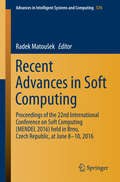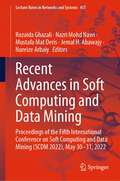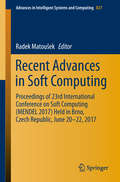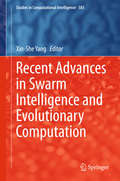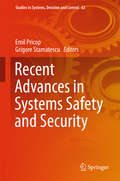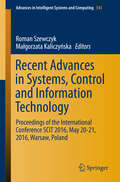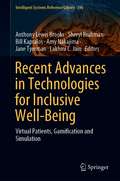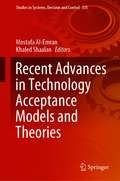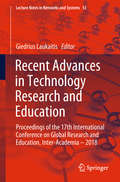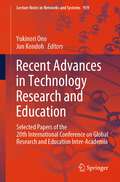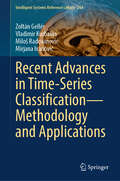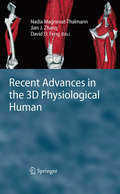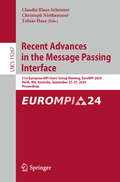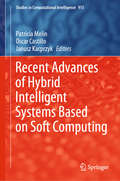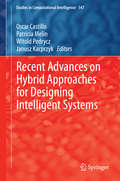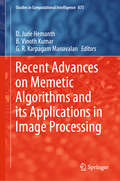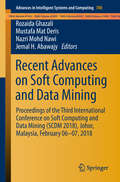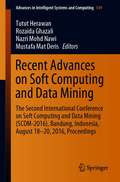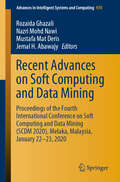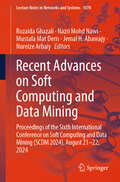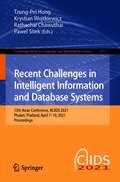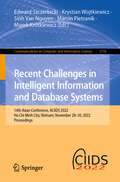- Table View
- List View
Recent Advances in Smart Manufacturing and Materials: Select Proceedings of ICEM 2020 (Lecture Notes in Mechanical Engineering)
by Rajeev Agrawal Jinesh Kumar Jain Vinod Singh Yadav Vijaya Kumar Manupati Leonilde VarelaThis book presents select proceedings of the International Conference on Evolution in Manufacturing (ICEM 2020), and examines a range of areas including internet-of-things for cyber manufacturing, data analytics for manufacturing systems and processes and materials. The topics covered include modeling simulation and decision making in cyber physical systems for supporting engineering and production management, innovative approach in materials development, biomaterial applications, and advancement in manufacturing and material technologies. The book also discusses sustainability in manufacturing and supply chain management including circular economy. The book will be a valuable reference for beginners, researchers, and professionals interested in smart manufacturing in engineering, production management and materials technology.
Recent Advances in Soft Computing
by Radek MatoušekThis proceeding book contains a collection of selected accepted papers of the Mendel conference held in Brno, Czech Republic in June 2016. The proceedings book contains three chapters which present recent advances in soft computing including intelligent image processing. The Mendel conference was established in 1995 and is named after the scientist and Augustinian priest Gregor J. Mendel who discovered the famous Laws of Heredity. The main aim of the conference is to create a regular possibility for students, academics and researchers to exchange ideas and novel research methods on a yearly basis.
Recent Advances in Soft Computing and Data Mining: Proceedings of the Fifth International Conference on Soft Computing and Data Mining (SCDM 2022), May 30-31, 2022 (Lecture Notes in Networks and Systems #457)
by Jemal H. Abawajy Rozaida Ghazali Nazri Mohd Nawi Mustafa Mat Deris Nureize ArbaiyThis book unfolds ways to transform data into innovative solutions perceived as new remarkable and meaningful value. It offers practical views of the concepts and techniques readers need to get the most out of their large-scale research and data mining projects. It strides them through the data-analytical thinking, circumvents the difficulty in deciphering complex data systems and obtaining commercialization value from the data. Also known as data-driven science, soft computing and data mining disciplines cover a broad spectrum, an interdisciplinary field of scientific methods and processes. The book, Recent Advances in Soft Computing and Data Mining, delivers sufficient knowledge to tackle a wide range of issues seen in complex systems. This is done by exploring a vast combination of practices and applications by incorporating these two domains. To thrive in these data-driven ecosystems, researchers, data analysts, and practitioners must choose the best design to approach the problem with the most efficient tools and techniques. To thrive in these data-driven ecosystems, researchers, data analysts, and practitioners must understand the design choice and options of these approaches, thus to better appreciate the concepts, tools, and techniques used.
Recent Advances in Soft Computing: Proceedings of 23rd International Conference on Soft Computing (MENDEL 2017) Held in Brno, Czech Republic, June 20-22, 2017 (Advances in Intelligent Systems and Computing #837)
by Radek MatoušekThis book presents selected papers from the MENDEL conference that was held in Brno, Czech Republic in June 2017. Consisting of two parts, the book discusses recent advances in soft computing, including intelligent image processing: Part 1 addresses evolutionary computing, swarm intelligence, metaheuristics, and optimization; Part 2 then focuses on neural networks, machine learning, self-organization, fuzzy systems, and advanced statistics. The MENDEL conference was established in 1995 and it bears the name of the scientist and Augustinian priest Gregor J. Mendel, who discovered the famous Laws of Heredity. The main aim of the conference was to create a regular opportunity for students, academics and researchers to exchange their ideas and novel research methods.
Recent Advances in Sustainable Energy and Intelligent Systems: 7th International Conference on Life System Modeling and Simulation, LSMS 2021 and 7th International Conference on Intelligent Computing for Sustainable Energy and Environment, ICSEE 2021, Hangzhou, China, October 30 – November 1, 2021, Proceedings, Part II (Communications in Computer and Information Science #1468)
by Kang Li Jinghan He Qun Niu Zhile Yang Tim Coombs Yuchu TianThe three-volume set CCIS 1467, CCIS 1468, and CCIS 1469 constitutes the thoroughly refereed proceedings of the 7th International Conference on Life System Modeling and Simulation, LSMS 2021, and of the 7th International Conference on Intelligent Computing for Sustainable Energy and Environment, ICSEE 2021, held in Hangzhou, China, in October 2021. The 159 revised papers presented were carefully reviewed and selected from over 430 submissions.The papers of this volume are organized in topical sections on: Medical Imaging and Analysis Using Intelligence Computing; Biomedical signal processing, imaging, visualization and surgical robotics; Computational method in taxonomy study and neural dynamics; Intelligent medical apparatus, clinical applications and intelligent design of biochips; Power and Energy Systems; Computational Intelligence in Utilization of Clean and Renewable Energy Resources, and Intelligent Modelling, Control and Supervision for Energy Saving and Pollution Reduction; Intelligent Methods in Developing Electric Vehicles, Engines and Equipment; Intelligent Control Methods in Energy Infrastructure Development and Distributed Power Generation Systems; Intelligent Modeling, Simulation and Control of Power Electronics and Power Networks; Intelligent Techniques for Sustainable Energy and Green Built Environment, Water Treatment and Waste Management; Intelligent Robot and Simulation; Intelligent Data Processing, Analysis and Control in Complex Systems; Advanced Neural Network Theory and Algorithms; Advanced Computational Methods and Applications; Fuzzy, Neural, and Fuzzy-neuro Hybrids; Intelligent Modelling, Monitoring, and Control of Complex Nonlinear Systems; Intelligent manufacturing, autonomous systems, intelligent robotic systems; Computational Intelligence and Applications.
Recent Advances in Swarm Intelligence and Evolutionary Computation
by Xin-She YangThis timely review volume summarizes the state-of-the-art developments in nature-inspired algorithms and applications with the emphasis on swarm intelligence and bio-inspired computation. Topics include the analysis and overview of swarm intelligence and evolutionary computation, hybrid metaheuristic algorithms, bat algorithm, discrete cuckoo search, firefly algorithm, particle swarm optimization, and harmony search as well as convergent hybridization. Application case studies have focused on the dehydration of fruits and vegetables by the firefly algorithm and goal programming, feature selection by the binary flower pollination algorithm, job shop scheduling, single row facility layout optimization, training of feed-forward neural networks, damage and stiffness identification, synthesis of cross-ambiguity functions by the bat algorithm, web document clustering, truss analysis, water distribution networks, sustainable building designs and others. As a timely review, this book can serve as an ideal reference for graduates, lecturers, engineers and researchers in computer science, evolutionary computing, artificial intelligence, machine learning, computational intelligence, data mining, engineering optimization and designs.
Recent Advances in Systems Safety and Security
by Emil Pricop Grigore StamatescuThis book represents a timely overview of advances in systems safety and security, based on selected, revised and extended contributions from the 2nd and 3rd editions of the International Workshop on Systems Safety and Security - IWSSS, held in 2014 and 2015, respectively, in Bucharest, Romania. It includes 14 chapters, co-authored by 34 researchers from 7 countries. The book provides an useful reference from both theoretical and applied perspectives in what concerns recent progress in this area of critical interest. Contributions, broadly grouped by core topic, address challenges related to information theoretic methods for assuring systems safety and security, cloud-based solutions, image processing approaches, distributed sensor networks and legal or risk analysis viewpoints. These are mostly accompanied by associated case studies providing additional practical value and underlying the broad relevance and impact of the field.
Recent Advances in Systems, Control and Information Technology
by Roman Szewczyk Małgorzata KaliczyńskaThis book presents the proceedings of the International Conference on Systems, Control and Information Technologies 2016. It includes research findings from leading experts in the fields connected with INDUSTRY 4. 0 and its implementation, especially: intelligent systems, advanced control, information technologies, industrial automation, robotics, intelligent sensors, metrology and new materials. Each chapter offers an analysis of a specific technical problem followed by a numerical analysis and simulation as well as the implementation for the solution of a real-world problem.
Recent Advances in Technologies for Inclusive Well-Being: Virtual Patients, Gamification and Simulation (Intelligent Systems Reference Library #196)
by Lakhmi C. Jain Anthony Lewis Brooks Bill Kapralos Jane Tyerman Sheryl Brahman Amy NakajimaIn a time of ongoing pandemic when well-being is a priority this volume presents latest works across disciplines associated to Virtual Patients, Gamification and Simulation. Chapters herein present international perspectives with authors from around the globe contributing to this impactful third edition to the series following a 2014 Springer book on Technologies for Inclusive Well-Being and a 2017 Springer book Recent Advances in Technologies for Inclusive Well-Being. Digital technologies are pervasive in life and the contributions herein focus on specific attributes and situations, especially in training and treatment programmes spanning across ranges of diagnosis, conditions, ages, and targeted impacts. This volume purposefully does not cover all (even if that was possible) aspects on how virtual interactive space can align to statial computing, which in turn can align with related embodied entities (whatever the terms used e.g. Virtual, Augmented, Extended, Mixed Realities) along with AI, Deep Learning etc. It also doesn’t cover what some may refer to as ‘trendy terms’ such as 360 degree, video, WebXR, cryptocurrency, blockchain, virtual goods, AR museums, travel and teleportation…however, what is covered in this book, and the prior volumes it builds upon (as above), is a sharing and questioning of advancing technologies for inclusive well-being through research and practices from an avant-garde perspective.
Recent Advances in Technology Acceptance Models and Theories (Studies in Systems, Decision and Control #335)
by Khaled Shaalan Mostafa Al-EmranThis book tackles the latest research trends in technology acceptance models and theories. It presents high-quality empirical and review studies focusing on the main theoretical models and their applications across various technologies and contexts. It also provides insights into the theoretical and practical aspects of different technological innovations that assist decision-makers in formulating the required policies and procedures for adopting a specific technology.
Recent Advances in Technology Research and Education: Proceedings Of The 17th International Conference On Global Research And Education Inter-academia - 2018 (Lecture Notes in Networks and Systems #53)
by Giedrius LaukaitisThis book presents the proceedings of the 17th International Conference on Global Research and Education, Inter-Academia 2018 held in Kaunas, Lithuania on 24–27 September 2018. The main goal of the conference was to provide an international forum to review, stimulate, and understand the recent trends in both fundamental and applied research. In addition to increasing interest in recent research findings, the conference aimed to strengthen the cooperation between the partners of the Inter-Academia community towards new theoretical and practical research advances. The papers included cover topics in the fields of material science and technology, nanotechnology, plasma physics, biotechnology and environmental engineering, electric and electronic engineering, robotics, measurement, identification, and control, soft computing techniques and modeling, multimedia and e-Learning. The book is a valuable scientific reference resource for the global scientific community.
Recent Advances in Technology Research and Education: Selected Papers of the 20th International Conference on Global Research and Education Inter-Academia (Lecture Notes in Networks and Systems #939)
by Yukinori Ono Jun KondohThis book presents the 20th edition of the Inter-Academia Conference which aims to be a valuable resource for academic institutions in search for novel approaches for a global education, for industry partners exploring new fundamental research ideas, for government bodies seeking international projects that promote sustainable growth, and most certainly for the global scientific community, more and more invested in the multi-disciplinarity of modern research. Interdisciplinary research collaboration is crucial for solving many pressing issues and challenges facing society today. Bringing together researchers and educators from different disciplines allows a more holistic understanding of complex problems, providing also the opportunity for new learning and for collaboration on complex projects. Beyond its scientific merits and value, Inter-Academia also promotes a culture of intellectual diversity, innovative thinking, and global perspective that can foster breakthrough discoveries, unexpected advancements in research, and, last but not least, a sense of belonging to a global community. Being established in 2002, the Inter-Academia Community currently gathers researchers from 14 leading Universities in Eastern and Central Europe, together with Shizuoka University, in Japan. As such, the Inter-Academia Community serves as a strong bond across continents, allowing the development of a number of global projects for student and researcher mobility, with a significant impact on the broader scientific community. The peer-reviewed papers included in this book hopefully stimulate further interactions and collaborations covering both fundamental and applied research, with benefits for the global society.
Recent Advances in Time-Series Classification—Methodology and Applications (Intelligent Systems Reference Library #264)
by Mirjana Ivanović Miloš Radovanović Zoltán Gellér Vladimir KurbalijaThis book examines the impact of such constraints on elastic time-series similarity measures and provides guidance on selecting suitable measures. Time-series classification frequently relies on selecting an appropriate similarity or distance measure to compare time series effectively, often using dynamic programming techniques for more robust results. However, these techniques can be computationally demanding, which results in the usage of global constraints to reduce the search area in the dynamic programming matrix. While these constraints cut computation time significantly (by up to three orders of magnitude), they may also affect classification accuracy. Additionally, the importance of the nearest neighbor classifier (1NN) is emphasized for its strong performance in time-series classification, alongside the kNN classifier which offers stable results. This book further explores the weighted kNN classifier, which gives closer neighbors more influence, showing how it merges accuracy and stability for improved classification outcomes.
Recent Advances in the 3D Physiological Human
by Nadia Magnenat-Thalmann Jian J. Zhang David Dagan FengResearch into the 3D Physiological Human is a very active field focusing on the creation of patient-specific computer models for personalised healthcare. Reporting on how these models can simulate and provide a better understanding of human physiology and pathology, this book also looks at how the evolution and the improvement of technological devices such as scanners, medical instruments, and computer power have helped in our understanding of the human body and its functionalities. The book contains contributions from leading researchers from a variety of disciplines (including computer graphics, biomechanics, knowledge representation, human-machine interfaces etc) associated with medical imaging, simulation, computer-assisted surgery and 3D semantics. Divided into three parts: anatomical and physiological modelling, physically-based simulation, and medical analysis and knowledge management, this book provides a clear picture of the most recent advances in this increasingly important area.
Recent Advances in the Message Passing Interface: 31st European MPI Users' Group Meeting, EuroMPI 2024, Perth, WA, Australia, September 25–27, 2024, Proceedings (Lecture Notes in Computer Science #15267)
by Christoph Niethammer Tobias Haas Claudia Blaas-SchennerThis volume LNCS constitutes the refereed proceedings of 31st European MPI Users' Group Meeting, EuroMPI 2024, held in Perth, WA, Australia, during September 25-27, 2024. The 8 full papers presented here were carefully reviewed and selected from 19 submissions. These papers have been categorized under the following topical sections: Compile-time Correctness checks and optimization; Limitations and Extensions for GPGPUs in MPI; Improvements for MPI and MPI Ecosystem.
Recent Advances of Hybrid Intelligent Systems Based on Soft Computing (Studies in Computational Intelligence #915)
by Oscar Castillo Patricia Melin Janusz KacprzykThis book describes recent advances on fuzzy logic, neural networks and optimization algorithms, as well as their hybrid combinations, and their application in areas such as intelligent control and robotics, pattern recognition, medical diagnosis, time series prediction and optimization of complex problems. The book contains a collection of papers focused on hybrid intelligent systems based on soft computing. There are some papers with the main theme of type-1 and type-2 fuzzy logic, which basically consists of papers that propose new concepts and algorithms based on type-1 and type-2 fuzzy logic and their applications. There are also some papers that present theory and practice of meta-heuristics in different areas of application. Another group of papers describes diverse applications of fuzzy logic, neural networks and hybrid intelligent systems in medical applications. There are also some papers that present theory and practice of neural networks in different areas of application. In addition, there are papers that present theory and practice of optimization and evolutionary algorithms in different areas of application. Finally, there are some papers describing applications of fuzzy logic, neural networks and meta-heuristics in pattern recognition problems.
Recent Advances on Hybrid Approaches for Designing Intelligent Systems
by Witold Pedrycz Oscar Castillo Patricia Melin Janusz KacprzykThis book describes recent advances on hybrid intelligent systems using soft computing techniques for diverse areas of application, such as intelligent control and robotics, pattern recognition, time series prediction and optimization complex problems. Soft Computing (SC) consists of several intelligent computing paradigms, including fuzzy logic, neural networks and bio-inspired optimization algorithms, which can be used to produce powerful hybrid intelligent systems. The book is organized in five main parts, which contain a group of papers around a similar subject. The first part consists of papers with the main theme of type-2 fuzzy logic, which basically consists of papers that propose new models and applications for type-2 fuzzy systems. The second part contains papers with the main theme of bio-inspired optimization algorithms, which are basically papers using nature-inspired techniques to achieve optimization of complex optimization problems in diverse areas of application. The third part contains papers that deal with new models and applications of neural networks in real world problems. The fourth part contains papers with the theme of intelligent optimization methods, which basically consider the proposal of new methods of optimization to solve complex real world optimization problems. The fifth part contains papers with the theme of evolutionary methods and intelligent computing, which are papers considering soft computing methods for applications related to diverse areas, such as natural language processing, recommending systems and optimization.
Recent Advances on Memetic Algorithms and its Applications in Image Processing (Studies in Computational Intelligence #873)
by D. Jude Hemanth B. Vinoth Kumar G. R. Karpagam ManavalanThis book includes original research findings in the field of memetic algorithms for image processing applications. It gathers contributions on theory, case studies, and design methods pertaining to memetic algorithms for image processing applications ranging from defence, medical image processing, and surveillance, to computer vision, robotics, etc. The content presented here provides new directions for future research from both theoretical and practical viewpoints, and will spur further advances in the field.
Recent Advances on Soft Computing and Data Mining
by Jemal H. Abawajy Rozaida Ghazali Nazri Mohd Nawi Mustafa Mat DerisThis book offers a systematic overview of the concepts and practical techniques that readers need to get the most out of their large-scale data mining projects and research studies. It guides them through the data-analytical thinking essential to extract useful information and obtain commercial value from the data. Presenting the outcomes of International Conference on Soft Computing and Data Mining (SCDM-2017), held in Johor, Malaysia on February 6-8, 2018, it provides a well-balanced integration of soft computing and data mining techniques. The two constituents are brought together in various combinations of applications and practices. To thrive in these data-driven ecosystems, researchers, engineers, data analysts, practitioners, and managers must understand the design choice and options of soft computing and data mining techniques, and as such this book is a valuable resource, helping readers solve complex benchmark problems and better appreciate the concepts, tools, and techniques employed.
Recent Advances on Soft Computing and Data Mining
by Tutut Herawan Rozaida Ghazali Nazri Mohd Nawi Mustafa Mat DerisThis book provides a comprehensive introduction and practical look at the concepts and techniques readers need to get the most out of their data in real-world, large-scale data mining projects. It also guides readers through the data-analytic thinking necessary for extracting useful knowledge and business value from the data. The book is based on the Soft Computing and Data Mining (SCDM-16) conference, which was held in Bandung, Indonesia on August 18th-20th 2016 to discuss the state of the art in soft computing techniques, and offer participants sufficient knowledge to tackle a wide range of complex systems. The scope of the conference is reflected in the book, which presents a balance of soft computing techniques and data mining approaches. The two constituents are introduced to the reader systematically and brought together using different combinations of applications and practices. It offers engineers, data analysts, practitioners, scientists and managers the insights into the concepts, tools and techniques employed, and as such enables them to better understand the design choice and options of soft computing techniques and data mining approaches that are necessary to thrive in this data-driven ecosystem.
Recent Advances on Soft Computing and Data Mining: Proceedings of the Fourth International Conference on Soft Computing and Data Mining (SCDM 2020), Melaka, Malaysia, January 22–23, 2020 (Advances in Intelligent Systems and Computing #978)
by Jemal H. Abawajy Rozaida Ghazali Nazri Mohd Nawi Mustafa Mat DerisThis book provides an introduction to data science and offers a practical overview of the concepts and techniques that readers need to get the most out of their large-scale data mining projects and research studies. It discusses data-analytical thinking, which is essential to extract useful knowledge and obtain commercial value from the data. Also known as data-driven science, soft computing and data mining disciplines cover a broad interdisciplinary range of scientific methods and processes. The book provides readers with sufficient knowledge to tackle a wide range of issues in complex systems, bringing together the scopes that integrate soft computing and data mining in various combinations of applications and practices, since to thrive in these data-driven ecosystems, researchers, data analysts and practitioners must understand the design choice and options of these approaches. This book helps readers to solve complex benchmark problems and to better appreciate the concepts, tools and techniques used.
Recent Advances on Soft Computing and Data Mining: Proceedings of the Sixth International Conference on Soft Computing and Data Mining (SCDM 2024), August 21-22, 2024 (Lecture Notes in Networks and Systems #1078)
by Jemal H. Abawajy Rozaida Ghazali Nazri Mohd Nawi Mustafa Mat Deris Nureize ArbaiyThis book explores methods for leveraging data to create innovative solutions that offer significant and meaningful value. It provides practical insights into the concepts and techniques essential for maximizing the outcomes of large-scale research and data mining projects. Readers are guided through analytical thinking processes, addressing challenges in deciphering complex data systems and deriving commercial value from the data. Soft computing and data mining, also known as data-driven science, encompass a diverse range of interdisciplinary scientific methods and processes. The proceedings of "Recent Advances on Soft Computing and Data Mining" provide comprehensive knowledge to address various challenges encountered in complex systems. By integrating practices and applications from both domains, it offers a robust framework for tackling these issues. To excel in data-driven ecosystems, researchers, data analysts, and practitioners must carefully select the most suitable approaches and tools. Understanding the design choices and options available is essential for appreciating the underlying concepts, tools, and techniques utilized in these endeavors.
Recent Advances on Soft Computing and Data Mining: The Second International Conference on Soft Computing and Data Mining (SCDM-2016), Bandung, Indonesia, August 18-20, 2016 Proceedings (Advances in Intelligent Systems and Computing #549)
by Tutut Herawan Rozaida Ghazali Nazri Mohd Nawi Mustafa Mat DerisThis book provides a comprehensive introduction and practical look at the concepts and techniques readers need to get the most out of their data in real-world, large-scale data mining projects. It also guides readers through the data-analytic thinking necessary for extracting useful knowledge and business value from the data.The book is based on the Soft Computing and Data Mining (SCDM-16) conference, which was held in Bandung, Indonesia on August 18th–20th 2016 to discuss the state of the art in soft computing techniques, and offer participants sufficient knowledge to tackle a wide range of complex systems. The scope of the conference is reflected in the book, which presents a balance of soft computing techniques and data mining approaches. The two constituents are introduced to the reader systematically and brought together using different combinations of applications and practices. It offers engineers, data analysts, practitioners, scientists and managers the insights into the concepts, tools and techniques employed, and as such enables them to better understand the design choice and options of soft computing techniques and data mining approaches that are necessary to thrive in this data-driven ecosystem.
Recent Challenges in Intelligent Information and Database Systems: 13th Asian Conference, ACIIDS 2021, Phuket, Thailand, April 7–10, 2021, Proceedings (Communications in Computer and Information Science #1371)
by Tzung-Pei Hong Krystian Wojtkiewicz Rathachai Chawuthai Pawel SitekThis volume constitutes the refereed proceedings of the 13th Asian Conference on Intelligent Information and Database Systems, ACIIDS 2021, held in Phuket, Thailand, in April 2021. The total of 35 full papers accepted for publication in these proceedings were carefully reviewed and selected from 291 submissions. The papers are organized in the following topical sections: data mining and machine learning methods; advanced data mining techniques and applications; intelligent and contextual systems; natural language processing; network systems and applications; computational imaging and vision; decision support and control systems; data modelling and processing for Industry 4.0.
Recent Challenges in Intelligent Information and Database Systems: 14th Asian Conference, ACIIDS 2022, Ho Chi Minh City, Vietnam, November 28-30, 2022, Proceedings (Communications in Computer and Information Science #1716)
by Edward Szczerbicki Marcin Pietranik Marek Krótkiewicz Krystian Wojtkiewicz Sinh Van NguyenThis book constitutes the refereed proceedings of the 14th Asian Conference on Intelligent Information and Database Systems, ACIIDS 2022, held in Ho Chi Minh City, Vietnam, in November 2022. This volume contains 60 peer-reviewed papers selected for poster presentation from 406 submissions. Papers included in this volume cover the following topics: data mining and machine learning methods, advanced data mining techniques and applications, intelligent and contextual systems, natural language processing, network systems and applications, computational imaging and vision, decision support and control systems, and data modeling and processing for industry 4.0.

